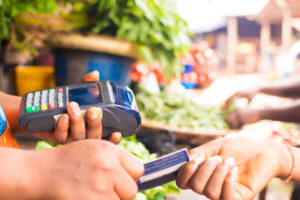
Smartphones and high-speed Internet access have changed banking in emerging markets forever more. One-size-fits-all is no longer fit for purpose as consumers demand to be treated as individuals. New entrants understanding these market dynamics are building lean digital services that put the consumer front-of-mind. It is a real warning to incumbents that failing to innovate puts them at real risk of being consigned to the rank of an also-ran.
However, there is still time for established institutions to compete and win, even though the battle lines have already been drawn. The heft, experience, and talent employed by large institutions gives them more than a fighting chance of winning over new and existing customers.
The modern global consumer expects to be able to log in, check their balance and make payments instantly on multiple platforms including their mobile, wherever they are. It is becoming pretty clear that the customer experience is the important differential. And personalization is the secret to developing this engaging and easily navigable experience. Underpinning the best in modern digital banking is a secure and convenient journey.
Our research supports this. Of the 73% of South Africans able to use eBanking services either online or on a mobile app, only 62% do so. We wanted to know why this might be, and found that 78% are concerned about data breaches when making online transactions. Given this sentiment, you have to question why only 36% of eBanking users have access to two-factor authentication – something proven time and time to protect customer details. Banks in emerging markets need to do more to reassure their customers that digital banking is secure.
The rise of adaptive security
Customer behaviors are evolving too, especially among young consumers. They are increasingly open to biometric authentication for instance. And coupled with new risk assessment platforms built on machine learning technology, it is now possible to increase the certainty that the customer is who they say they are.
The impressive feature in these new risk assessment platforms is that it proportions a probability that a fraudulent interaction is underway and triggers an appropriate response to match. Machine learning draws upon a customer’s geo-location, device profile, and behavioral biometric data to build up a picture of the user. The resulting security measures are robust and convenient, but most importantly what we call adaptive.
Let’s say Michael buys lunch from his favorite restaurant in Johannesburg when suddenly an ecommerce transaction is made in his name from a different country. The system immediately recognizes the unusual purchase made from a new device that comes from an IP address in a different geographical location. Michael will then receive a notification on his mobile to verify the suspicious purchase by providing fingerprint approval. Of course, Michael is highly unlikely to agree to the purchase and so avoids becoming a victim of fraud.
This approach offers benefits for both consumers and banks. Financial institutions cut operational and administrative costs as unusual purchasing patterns as picked up instantly and automatically with no human involvement required. Plus, the bank gets detailed information about the potential fraud. Michael feels secure and welcomes the efforts his bank has made to protect his money, something that in turn boosts the bank’s reputation.
In the past, he might have received a phone call that said fraud had been detected in another country, that his money had been spent without his knowledge and his account frozen. His card would have been blocked, and he’d have had to wait days for a replacement.
Now, customers can enjoy an effective security solution that is seamless, quick and personalized. The risk assessment platform changes the number of verification steps to authenticate identity dependent on the type of transaction and its risk profile.
We know that convenience remains non-negotiable. Multi-layered security can’t detract from the customer experience or prevent personalization. For a solution to be best-in-class, the digital experience must be frictionless and come equipped with sophisticated security mechanisms built around each individual customer.
In our increasingly mobile personalized world, banks are discovering that there’s no longer a “one-size-fits-all” approach. African customers are eager to adopt new technology and all types of banks from established big-hitters to up-and-coming digital only challengers must put security, convenience and personalization at the heart of their offer.


